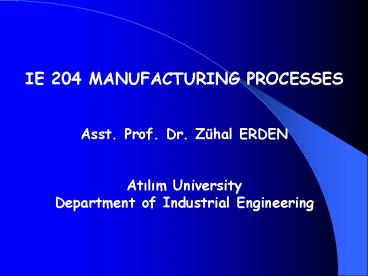IE 204 MANUFACTURING PROCESSES - PowerPoint PPT Presentation
1 / 19
Title:
IE 204 MANUFACTURING PROCESSES
Description:
used in manufacturing. Artificial Intelligence (AI) Expert Systems ... Quality is fitness for use. is conformance to requirements. means the characteristic or group or ... – PowerPoint PPT presentation
Number of Views:97
Avg rating:3.0/5.0
Title: IE 204 MANUFACTURING PROCESSES
1
IE 204 MANUFACTURING PROCESSES Asst. Prof.
Dr. Zühal ERDEN Atilim University Department of
Industrial Engineering
2
Manufacturing
Process of converting raw materials into products
( Making products from raw materials by various
processes, machinery and operations following a
well-organized plan for each activity required)
Manufacturing
Production
a number of changes
Raw material
Useful product
A manufactured item has a value defined as a
monetary worth or marketable price
3
Manufacturing may produce,
- DISCRETE PRODUCTS
- Individual parts or part pieces
- (nails, gears, engine blocks etc.)
- CONTINUOUS PRODUCTS
- May be cut into individual pieces
- (a spool of wire, metal or plastic sheet, tubes,
pipes etc.)
4
Product design and development
Process planning
Marketing, sales
Support services
Resources Materials, Capital, Energy, People
Shipping
Purchasing
Production control
Manufacturing
5
Demands and trends in manufacturing
- Design requirements and specifications
- Economical methods cost minimization
- Total quality from design to assembly
- Flexibility in production methods
- Evaluation of new developments in materials,
production methods and computer integration - System approach
- High productivity optimum use of all resources
6
Definition of product needmarketing information
Conceptual design and evaluationfeasibility study
Design analysis codes/standards review Physical
and analytical models
Computer-aided design (CAD)
Prototype production testing and evaluation
Production drawingsinstruction manuals
Material specification process and equipment
selection safety review
Computer-aided manufacturing and process planning
(CAM and CAPP)
Pilot production
Production
Computer-integrated manufacturing (CIM)
Inspection and quality assurance
Packaging marketing and sales literature
Product
7
CONCURRENT ENGINEERING a systematic approach
integrating the design and manufacture of
products with the view of optimizing all elements
in the life cycle of the product
LIFE CYCLE all aspects of a product such as
design, development, production, distribution,
use and its ultimate disposal and recycling, are
considered simultaneously
RAPID PROTOTYPING relies on CAD/CAM and
various manufacturing techniques (using polymers
or metal powders) to produce prototypes in the
form of a solid physical model of a part rapidly
and at a low cost.
8
DESIGN FOR MANUFACTURE AND ASSEMBLY (DFM)
A comprehensive approach to production of goods
and integrates the design process with materials,
manufacturing methods,process planning, assembly
and quality assurance.
DESIGN FOR ASSEMBLY (DFA) DESIGN FOR DISASSEMBLY
Assembly
Ease, speed and cost of putting parts together
Disassembly
Products are taken apart for maintenance,
servicing or recycling of their components
DESIGN FOR MANUFACTURE ASSEMBLY (DFMA)
Design considering inherent interrelationships
between design and manufacturing
9
MATERIAL SELECTION
- Ferrous metals (carbon, alloy, stainless, and
tool and die steels - Nonferrous metals and alloys (aluminum,
magnesium, copper, - nickel, titanium, superalloys etc.)
- Plastics (thermoplastics, thermosets,
elastomers) - Ceramics, glass ceramics, glasses, graphite and
diamond - Composite materials (reinforced composites,
metal-matrix, - ceramic-matrix composites, honetcomb structures)
10
SELECTING MANUFACTURING PROCESSES
- CASTING (expendable mold and permanent mold)
- FORMING AND SHAPING (rolling, forging,
extrusion, - drawing, sheet forming, powder metallurgy and
molding) - MACHINING (turning, boring, drilling, milling,
planing, - shaping, broaching, grinding, ultrasonic
machining, - chemical, electrical and electrochemical
machining and - high-energy beam machining)
- JOINING (welding, brazing, soldering, diffusion
bonding, - adhesive bonding and mechanical joining)
- FINISHING (honning, lapping, polishing,
burnishing, - deburring, surface treating, coating, plating)
11
COMPUTER-INTEGRATED MANUFACTURING
Machine Control Systems
Numerical Control (NC)
Adaptive Control (AC)
Computer Numerical Control (CNC)
NC A method of controlling the movements of
machine components by direct insertion of coded
instructions in the form of numerical data CNC
Numerical control, in which a computer (usually
microprocessor) is part of the controller AC
Control of a process that responds to changes in
the manufacturing operating conditions. Process
parameters are adjusted automatically to Optimize
production rate, production quality and minimize
cost.
12
The Basic NC Process
Engineering design of a part
Develop manufacturing plan for the part
Program numerical control instructions
Process the program to develop cutter location
data set
Postprocess for a specific machine tool
Input medium for machine tool
13
- Automated Handling of Materials
- Automated Guided Vehicles (AGVs)
- Automatic Storage and Retrieval Systems (ASRS)
- Industrial Robots
- Automated Robotic Assembly Systems
14
COMPUTER TECHNOLOGY
COMPUTER-AIDED DESIGN (CAD) conceptualization,
drawing-drafting, simulation and analysis of
engineering design by using various computer
tools COMPUTER-AIDED MANUFACTURING (CAM) An
approach to organizing a manufacturing plant, so
that all possible analyses, decisions and
actions are assigned to a master
computer COMPUTER-AIDED PROCESS PLANNING (CAPP)
An interactive computer system that automates
process planning. Functions such as optimization
of process plans, reducing planning costs,
improving the consistency of product quality and
reliability, cost estimating and work standards
can be incorporated into the system.
15
Automation Flexibility in Manufacturing
Cellular Manufacturing
Group Technology (GT)
Parts can be grouped and produced by classifying
them according to similarities in design and
manufacturing
Flexible Manufacturing Systems (FMS)
Process plans can be standardized and families of
parts can be produced efficiently and economically
Just-in-time prouction (JIT)
16
Other tools of computer technologyused in
manufacturing
- Artificial Intelligence (AI)
- Expert Systems
- Artificial Neural Networks (ANN)
17
QUALITY ASSURANCE ANDTOTAL QUALITY MANAGEMENT
(TQM)
Quality Definitions Quality ? ? is fitness for
use ? is conformance to requirements ?
means the characteristic or group
or combination of characteristics
which distinguishes one article from another
18
To assure quality in a product so that a customer
can buy it with confidence and use it for a long
period of time with confidence and satisfaction
QUALITY ASSURANCE
19
TOTAL QUALITY MANAGEMENT (TQM)
The application of quantitative methods and
human resources to improve the materials and
services supplied to an organization, all the
processes within an organization, and the degree
to which the needs of customers are met, now and
in the future































